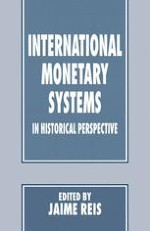1995 | OriginalPaper | Chapter
The Origins of the Fixed-Rate Dollar System
Author : Alan S. Milward
Published in: International Monetary Systems in Historical Perspective
Publisher: Palgrave Macmillan UK
Included in: Professional Book Archive
Activate our intelligent search to find suitable subject content or patents.
Select sections of text to find matching patents with Artificial Intelligence. powered by
Select sections of text to find additional relevant content using AI-assisted search. powered by
It has taken a long time for the mainstream of economic literature to accept that the Bretton Woods Agreements did not establish the working rules of the post-war international monetary system. The conventional periodisation, in which these rules were laid down in 1945, suspended by Britain’s failure to make sterling-dollar convertibility work in 1947, gradually reintroduced between 1949 and 1958, and then fully restored by the general return to dollar convertibility in 1958, seems likely at last to have been put aside. A new schematisation is suggested by McKinnon, in which the monetary system sketched out in the Bretton Woods Agreements had no applicability after 1950.1 What emerged by that year was the fixed-rate dollar system, enduring until 1970. In this new periodisation it is the ‘rules of the game’ which define the systems, a Bretton Woods system which failed to operate successfully between 1945 and 1950, and the subsequent fixed-rate dollar system — a period of relatively stable exchange rates exceeded in length and stability only by the international gold standard.
